TO
| Title | Date | Subject | Description | ||
|---|---|---|---|---|---|
| 26 |
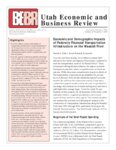 |
Economic and demographic impacts of federally financed transportation infrastructure on the Wasatch Front | 2004-09 | Over the next three decades, $14.4 billion (constant 2004 dollars) of new transit and highway infrastructure is planned to meet the transportation needs of the Wasatch Front.1 These investments will significantly influence the region's economic development potential, relative competitiveness, and la... | |
| 27 |
 |
Economic, demographic and fiscal impacts of closing Hill Air Force Base: a statewide and regional analysis | 2004-04 | The upcoming round of Defense Base Closure and Realignment (BRAC) is threatening the existence of Hill Air Force Base (Hill AFB). The Department of Defense is aggressively approaching this round of BRAC in its attempt to eliminate 20% to 25% of current capacity. The purpose of this study is to asses... | |
| 28 |
 |
Employment and population analysis and projections Ogden Metropolitan Area, Utah and the United States | 1963-07 | Thomas A. McLean and M r s . Connie P„ F a u l k n e r , graduate s t u d e n t s , and David L . Sutton, a senior student, in the Department of Economics, r e n d e r e d very valuable a s s i s t a n c e in the p r e p a r a t i o n of this r e p o r t. The Utah Department of Employment Se... | |
| 29 |
 |
Employment and population analysis and projections Provo metropolitan area, Utah and the United States | 1964-09 | This is the third and final report analyzing and projecting the employment profile and estimating the future population of Utah's three Metropolitan Areas Salt Lake, Ogden, and Provo--as part of a transportation study of each area by the Utah State Highway Department and local government agencies ... | |
| 30 |
 |
Employment and population analysis and projections Salt Lake Metropolitan Area, Utah and the United States | 1962-09 | Thomas A. McLean and Mrs. Connie P. Faulkner, graduate students in the Department of Economics, rendered very valuable assistance in the preparation of this report. The Utah Department of Employment Security was most cooperative and helpful in making available the necessary basic data for this stud... | |
| 31 |
 |
Employment, population, income and automobiles in Salt Lake, Ogden, Provo Metropolitan Area and State of Utah | 1966-12 | William C a r l i s l e and Michael A. Stoddard, graduate students in the Department of Economics, rendered v e r y valuable a s s i s t a n c e in the p r e p a r a tion of t h i s r e p o r t . Gregory M. Nielson, graduate student in Mathematics, a s s i s t e d in computer programming, and Iver... | |
| 32 |
 |
Energy development in the Uintah Basin: economic and demographic impacts | 1981-07 | This report, "Energy Developments in the Uintah Basin: Economic and Demographic Impacts," is one of aseries of reports issued by the State Planning Coordinator's Office that are designed to support comprehensive planning and the development of a Utah growth management strategy. The report is intende... | |
| 33 |
 |
Estimates and projections of low income population in Utah 1970-1985 | 1977 | This i s one in a series of projections and estimates of "target populations" defined by the Utah Department of Social Services for planning, management, and budgeting purposes. The fourteen target populations are: | |
| 34 |
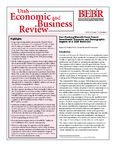 |
Fast-tracking Wasatch Front transit investments: economic and demographic impacts of a 2025 build-out | 2011 | Over the next 30 years, the Wasatch Front will significantly expand its transit network. Plans include the construction of an additional 25 miles of light rail, 76 miles of commuter rail, 227 miles of bus rapid transit, and 29 miles of mountain transportation rail line. These projects will be built ... | |
| 35 |
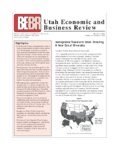 |
Immigrants transform Utah: entering a new era of diversity | 2004-05 | Utah is generally perceived as an extremely homogeneous state whose population can trace its ancestry mostly to northern Europe. Listings for surnames like Hansen, Jensen, and Christensen do fill many pages in local telephone directories throughout the state. According to census counts, the minority... | |
| 36 |
 |
Methodology for forecasting and allocating population, employment and land use along the Wasatch Front | 1970-09 | The report which follows presents a methodology for forecasting population, employment and land use patterns along the Wasatch Front. The methodology combines and mathematical model with a mapping analysis. Both are flexible and can be applied to transportation areas, counties, census tracts and tra... | |
| 37 |
 |
Model codes and analysis tools for quality growth | The following ordinance is designed as an OVERLAY zone for sensitive areas. It depends on a map, adopted as a zoning overlay map, that identifies the approximate areas where the sensitive lands will be located. The areas are described in this workbook. For the methods and sources of data that may be... | ||
| 38 |
 |
Multi-county regions in Utah | 1970-03 | The publication of this report was made possible through the financial assistance of the Four Corners Regional Commission with coordination by the State Planning Coordinator's Office, State of Utah. The statements, findings, conclusions, recommendations, and other data in this report are solely thos... | |
| 39 |
 |
Population characteristics of the Salt Lake Metropolitan Area | 1964-01 | This study could not have been undertaken without the assistance of many. An expression of gratitude is due Dr. Osmond L. Harline, Director of the Bureau of Economic and Business Research, and Dr. Clyde N. Randall, Dean of the College of Business, of the University of Utah, who responded to the orig... | |
| 40 |
 |
Procedure for using the matrix inversion routine | the spint modity programs allow the used to modity a spint matrix. It also, copies information at the beginning and end of a life which allows it to process impact files, etc. | ||
| 41 |
 |
Recreation in Utah a profile of the demand for outdoor recreation by out-of-state travelers to Utah | 1967-12 | A recurring problem when planning for economic and industrial development is the lack of sufficient basic data on which sound planning decisions can be based. One of the industry areas in which this lack of basic data has been conspicuous is the area of the out-of-state visitors' demand for Utah's o... | |
| 42 |
 |
Recreation in Utah a profile of the demand for outdoor recreation by Utah residents | 1966-01 | Are recurring problem in planning for economic and industrial development is the lack of sufficient basic data upon which sound planning decisions may be made. One of the industry areas in which the lack of basic data for planning is conspicuous by its scarcity is outdoor recreation. Yet the outdoor... | |
| 43 |
 |
Revised Utah population estimates for the 1990s | 2001-05 | Every 10 years, the U.S. Bureau of the Census conducts a population count. In the intervening years the Utah Population Es timates Committee (UPEC) annually prepares total resident population estimates for each of the 29 counties in the state. These estimates are based on methods that ut i l i z e s... | |
| 44 |
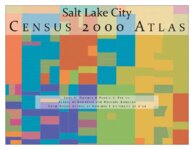 |
Salt Lake City census 2000 atlas | 2011-03 | Demographics; Salt Lake City; Utah; Census | This volume presents the basic demographic characteristics of residents of Salt Lake City as recorded in the 2000 Census of Population and Housing. Every ten years these federal governm ent counts of people are the basis of congressional apportionment and political redistricting. Data in this volume... |
| 45 |
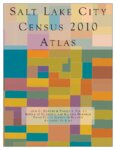 |
Salt Lake City census 2010 atlas | 2013-02 | Demographics; Salt Lake City; Utah; Census | This volume presents and analyzes results from the 2010 Census of Population and Housing. This mandatory enumeration is conducted by the federal government and is used to determine reapportionment and redistricting. This is the most complete record of population, households, and housing units that i... |
| 46 |
 |
Salt Lake County's distinctive demographics: implications for the aging population | 2006-12 | Salt Lake County; Projections; Estimates; Aging population; Baby boom; Utah; Salt Lake Aging Services; Kennecott Land | Salt Lake County is the economic, political, and cultural center of Utah. The county is currently home to nearly 40 percent of Utah residents and generates about half of all jobs in the state. It remains the most populous county, with a million of the state's 2.6 million residents,1 and its daytime ... |
| 47 |
 |
Salt Lake County's distinctive demographics: implications for the future | 2006-11 | Salt Lake County is the economic, political, and cultural center of Utah. The county is currently home to nearly 40% of Utah residents and generates about half of all jobs in the state. It remains the most populous county, with a million of the state's 2.6 million residents,2 and its daytime populat... | |
| 48 |
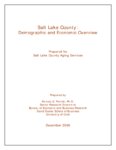 |
Salt Lake County: demographic and economic overview | 2006-12 | Salt Lake County; Utah; Demographics; Aging; Dependency ratio; Foreign born; Immigrants; Age structure; Age waves; Occupation; Labor force participation; Sex ratio; Educational attainment; commuting | Salt Lake County is the economic, political, and cultural center of Utah. The county is currently home to nearly 40 percent of Utah residents and generates about half of all jobs in the state. It remains the most populous county, with a million of the state's 2.6 million residents,1 and its daytime ... |
| 49 |
 |
State of Utah economic and demographic projections: 2000-2030, 2000 baseline highlights | 2001-01 | ||
| 50 |
 |
State of Utah economic and demographic projections: an analysis of the accuracy of UPED's historical projection work | 2001-04-01 |
